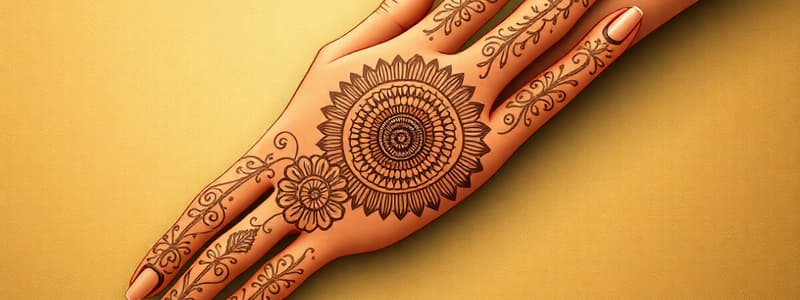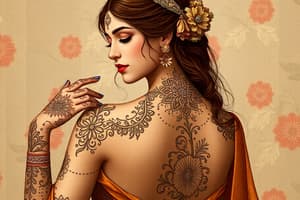Podcast
Questions and Answers
What is the primary purpose of using henna paste historically?
What is the primary purpose of using henna paste historically?
- To create vibrant colors for fabrics
- For its cooling effect on the skin (correct)
- To serve as a food preservative
- As a primary ingredient in traditional medicine
Which ingredient is NOT commonly mixed with henna leaves to create the paste?
Which ingredient is NOT commonly mixed with henna leaves to create the paste?
- Warm water
- Tea
- Vinegar (correct)
- Sugar
What is a typical practice during the Henna Night prior to a wedding?
What is a typical practice during the Henna Night prior to a wedding?
- Exchange of gifts between families
- A ceremonial meal preparation
- Henna applications by multiple artists (correct)
- Guest presentations and speeches
How has social media influenced the modern practice of henna?
How has social media influenced the modern practice of henna?
What aspect of henna is emphasized in its healing properties?
What aspect of henna is emphasized in its healing properties?
Which of the following statements about modern henna designs is accurate?
Which of the following statements about modern henna designs is accurate?
Which traditional use of henna is commonly associated with its applications for animals?
Which traditional use of henna is commonly associated with its applications for animals?
Why is henna traditionally used during special occasions like weddings?
Why is henna traditionally used during special occasions like weddings?
What is NOT a commonly mentioned application of henna in historical medical practices?
What is NOT a commonly mentioned application of henna in historical medical practices?
What serves as a unique characteristic of bridal henna patterns?
What serves as a unique characteristic of bridal henna patterns?
Flashcards are hidden until you start studying
Study Notes
Henna's Cultural Significance
- Henna is deeply embedded in Arab culture and heritage, particularly within desert communities.
- Traditional use involves collecting and grinding henna leaves to create a paste, mixed with warm water, lemon juice, tea, sugar, and essential oils.
- The paste serves dual purposes: decoration for hands and feet, and dyeing textiles and hair.
Historical Uses and Beautification
- Initially, henna was applied for its cooling effects on the skin, particularly on palms and soles.
- As the paste is removed, it leaves behind a stain, leading to its use in beautification practices.
Special Occasions and Henna Night Tradition
- Henna is prominently used during important events like weddings, engagements, and Eid celebrations.
- The Henna Night is a key tradition where the bride, along with family and friends, celebrates the upcoming wedding.
- Bridal henna designs can be intricate, often taking hours to complete and may involve multiple artists for elaborate patterns.
Medicinal Properties
- Henna is recognized as a herb with medicinal qualities derived from its oil, bark, and seeds.
- Historically, it has been applied topically for ailments such as headaches, stomach pains, burns, and open wounds.
- It offers sun protection and has been applied to animals to avert sunburn on sensitive parts like their noses.
Global Popularity and Modern Adaptations
- The popularity of henna has expanded globally, fueled by social media and migration.
- Contemporary henna artists innovate by creating new techniques and designs, ensuring the tradition remains vibrant and relevant.
- In the UAE, popular modern designs feature complex floral patterns, ribbons, and mesh-like arrangements.
- A growing trend includes gold temporary henna, exclusively used for special occasions, highlighting a blend of tradition and modernity.
Studying That Suits You
Use AI to generate personalized quizzes and flashcards to suit your learning preferences.




